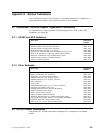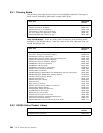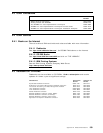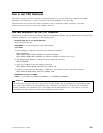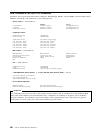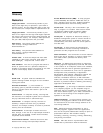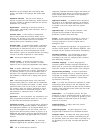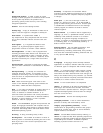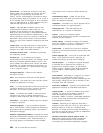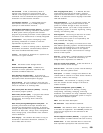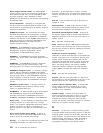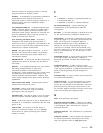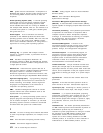
Glossary
Numerics
2-digit-year format. A format that provides a year
date as two digits only to represent a year within a
specific century. The two high-order digits of the year
are truncated; for example 1995 is represented as 95.
4-digit-year format. A format that provides a year
date as four digits: the two high-order digits represent
the century and the two low-order digits represent the
year within the century. For example, 1995 represents
the year 1995; 2095 represents the year 2095.
20th century. The period of time 0000.00 hrs
1901-January-1 through 2400.00 hrs
2000-December-31.
21st century. The period of time 0000.00 hrs
2001-January-1 through 2400.00 hrs
2100-December-31.
24-hour clock. A clock that keeps time from 0000
(midnight) to 1200 (noon) and from 1200 (noon) to
2400 (midnight). Compare with 12-hour clock.
3270 emulation. The use of a program that allows a
device or system such as a personal computer to
operate in conjunction with a host system as if it were
a 3270- series display station or control unit.
A
abend code. A system code that identifies the
system message number and type of error condition
causing the abend.
abnormal termination. (1) The cessation of
processing prior to planned termination. (2) A system
failure or operator action that causes a job to end
unsuccessfully.
access control. In computer security, ensuring that
the resources of a computer system can be accessed
only by authorized users in authorized ways.
access level. In computer security, the level of
authority a subject has when using a protected
resource; for example, authority to access a particular
security level of information.
access method. A technique to obtain the use of
data, storage, or the use of an input/output channel to
transfer data; for example, random access method,
sequential access method.
access method routines. Routines that move data
between main storage and input/output devices.
Access Method Services (AMS). A utility program
(named IDCAMS) that defines VSAM data sets (or
files), allocates space for them, modifies attributes,
and manipulates data sets and catalog entries.
access mode. The way a file is used within a job
step, a program, or a module. Most access modes
correspond to OPEN modes specified in OPEN
statements (such as input, output, or update).
access path. A sequence of data items used by a
database management system to access records or
other data items stored in a database. There may
simultaneously exist more than one access path for
one data item.
account file. A direct access file maintained by
VSE/POWER to hold the accounting information it
generates and the programs that it controls.
actual conversion. The conversion of source material
done at the end of migration, in order to switch over
from VSE to MVS. (Contrast with dummy mass
conversion.)
AD/Cycle. An IBM product that offers an enterprise
modeling approach supported by tools that will assist
in the creation of an enterprise model to be validated,
analyzed, and then used to generate applications. It
consists of a framework for, and a set of, application
development tools provided by an Application
Development (AD) platform, designed to support the
integration of tools through a consistent user
interface, workstation services, an AD information
model, tool services, Repository Services, and Library
Services. It provides control for defining and sharing
application development data.
address space. (1) The range of addresses available
to a computer program. (2) The complete range of
addresses that are available to a programmer. See
also virtual address space. (3) In VSE, a subdivision of
the total of virtual storage if the computer system
operates in 370 mode.
address translation. In virtual storage systems, the
process of changing the address of an item of data or
an instruction from its virtual storage address to its
real storage address.
AFP. Advanced Function Presentation. A set of
licensed programs, together with user applications,
that use the all-points-addressable concept to print on
presentation devices. AFP includes creating,
formatting, archiving, retrieving, viewing, distributing,
and printing information.
AFPDS. AFP data stream. A presentation data
stream that is processed in AFP environments.
Copyright IBM Corp. 1998 565



